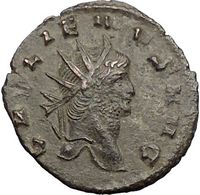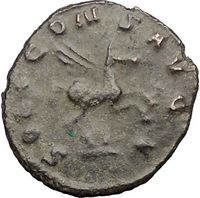|
Gallienus
-
Roman Emperor
: 253-268 A.D. - Joint Rule with
Valerian I 253-260 A.D. -
Bronze Antoninianus 21mm (3.24 grams) Rome mint. Sole reign 260-268 A.D.
Reference: Goebl 712; RIC V-1, Rome 283 var; Sear 10362.
GALLIENVS AVG, radiate head right
SOLI CONS AVG, Pegasus springing right. Officina letter A offset to right of
exergue.
You are bidding on the exact item pictured,
provided with a Certificate of Authenticity and Lifetime Guarantee of
Authenticity.
Pegasus is one of the best known mythological creatures in
Greek mythology
. He is a winged divine stallion
usually depicted as pure white in colour. He was sired by
Poseidon
, in his role as horse-god, and foaled
by the Gorgon
Medusa
. He was the brother of
Chrysaor
, born at a single birthing when his
mother was decapitated by Perseus. Greco-Roman poets write about his ascent to
heaven after his birth and his obeisance to
Zeus, king of the gods, who instructed him to bring lightning and
thunder from Olympus. Friend of the Muses, Pegasus is the creator of
Hippocrene
, the fountain on
Mt. Helicon
. He was captured by the Greek hero
Bellerophon
near the fountain Peirene with the
help of Athena and Poseidon. Pegasus allows the hero to ride him to defeat a
monster, the Chimera, before realizing many other exploits. His rider, however,
falls off his back trying to reach Mount Olympus. Zeus transformed him into the
constellation
Pegasus
and placed him up in the sky.

Bellerophon riding Pegasus
Hypotheses have been proposed regarding its relationship with the
Muses
, the gods
Athena
,
Poseidon
,
Zeus, Apollo
, and the hero
Perseus
.
The symbolism of Pegasus varies with time. Symbol of wisdom and especially of
fame from the Middle Ages until the Renaissance, he became one symbol of the
poetry and the creator of sources in which the poets come to draw inspiration,
particularly in the 19th century. Pegasus is the subject of a very rich
iconography, especially through the ancient Greek pottery and paintings and
sculptures of the Renaissance. Personification of the water, solar myth, or
shaman mount, Carl Jung and his followers have seen in Pegasus a profound
symbolic esoteric in relation to the spiritual energy that allows to access to
the realm of the gods on Mount Olympus.
In the 20th and 21st century, he appeared in movies, in fantasy, in video
games and in role play, where by extension, the term "pegasus" is often used to
refer to any winged horse.
Etymology

Pegasus, as the horse of Muses, was put on the roof of
Poznań Opera House
(Max
Littmann, 1910)
The poet Hesiod
presents a
folk etymology
if the name Pegasus as
derived from pēgē "spring, well": "the pegai of
Okeanos
, where he was born."
A proposed etymology of the name is
Luwian
pihassas, meaning "lightning",
and Pihassassi, a local Luwian-Hittite name in southern Cilicia of a
weather god represented with thunder and lightning. The proponents of this
etymology adduce Pegasus' role, reported as early as
Hesiod
, as bringer of thunderbolts to Zeus. It
was first suggested in 1952 and remains widely accepted, but
Robin Lane Fox
(2009) has criticized it as
implausible.
Pegasus and springs
According to legend, everywhere the winged horse struck his hoof to the
earth, an inspiring spring burst forth. One of these springs was upon the
Muses'
Mount Helicon
, the
Hippocrene
("horse spring"),[5]
opened,
Antoninus Liberalis
suggested,[6]
at the behest of
Poseidon
to prevent the
mountain
swelling with rapture at the song of
the Muses; another was at
Troezen
. Hesiod relates how Pegasus was
peacefully drinking from a spring when the hero
Bellerophon
captured him. Hesiod also says
Pegasus carried
thunderbolts
for
Zeus.
Birth
There are several versions of the birth of the winged stallion and his
brother Chrysaor
in the far distant place at the edge
of Earth, Hesiod's "springs of Oceanus, which encircles the inhabited earth,
where Perseus
found
Medusa
:
One is that they sprang from the blood issuing from Medusa's neck as
Perseus
was beheading her,[8]
similar to the manner in which
Athena
was born from the head of Zeus. In
another version, when Perseus beheaded Medusa, they were born of the Earth, fed
by the Gorgon's blood. A variation of this story holds that they were formed
from the mingling of Medusa's blood, Pain and sea foam, implying that Poseidon
had involvement in their making. The last version bears resemblance to the birth
of Aphrodite
, daughter of
Zeus.
Pedigree of Pegasus
Sire
Poseidon
|
Cronus
|
Uranus
|
Gaïa or Nyx
|
| Gaïa or Nyx |
|
Gaïa
|
Chaos
|
| Chaos |
|
Rhea
|
Uranus |
Gaïa or Nyx |
| Gaïa or Nyx |
| Gaïa |
Chaos |
| Chaos |
Dam
Medusa
|
Phorcys
|
Pontus
|
Ether
or Uranus |
| Gaïa |
| Gaïa |
Chaos |
| Chaos |
|
Ceto
|
Pontus |
Ether or Uranus |
| Gaïa |
| Gaïa |
Chaos |
| Chaos |
Bellerophon
Pegasus aided the hero
Bellerophon
in his fight against both the
Chimera
and the
Amazons
. There are varying tales as to how
Bellerophon found Pegasus; the most common says that the hero was told by
Polyeidos
to sleep in the
temple of Athena
, where the goddess visited him
in the night and presented him with a golden bridle. The next morning, still
clutching the bridle, he found Pegasus drinking at the
Pierian
spring and caught Pegasus, and
eventually tamed him.
Perseus
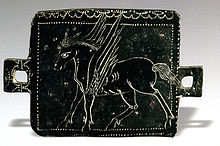
Parthian
era bronze plate depicting
Pegasus ("Pegaz" in Persian), excavated in
Masjed Soleyman
,
Khūzestān
,
Iran
.
Michaud's Biographie universelle relates that when Pegasus was born,
he flew to where thunder and lightning is released. Then, according to certain
versions of the myth, Athena tamed him and gave him to Perseus, who flew to
Ethiopia to help Andromeda.
In fact Pegasus is a late addition to the story of Perseus, who flew on his
own with the sandals loaned him by
Hermes
.
Olympus
Pegasus and Athena left Bellerophon to forge some sweet goods and continued
to Olympus where he was stabled with
Zeus' other steeds, and was given the task of carrying
Zeus' thunderbolts. Because of his faithful service to Zeus, he was
honored with transformation into a
constellation
. On the day of his
catasterism
, when Zeus transformed him into
a constellation, a single feather fell to the earth near the city of
Tarsus
.
Legacy
World War II

The emblem of the World War II, British Airborne Forces,
Bellerophon
riding the flying horse
Pegasus.
During
World War II
, the silhouetted image of
Bellerophon the warrior, mounted on the winged Pegasus, was adopted by the
United Kingdom
's newly-raised parachute troops
in 1941 as their upper sleeve insignia. The image clearly symbolized a warrior
arriving at a battle by air, the same tactics used by
paratroopers
. The square upper-sleeve insignia
comprised Bellerophon/Pegasus in light blue on a maroon background. The insignia
was designed by famous English novelist
Daphne du Maurier
, who was married to the
commander of the
1st Airborne Division
(and later the expanded
British Airborne Forces), General
Frederick "Boy" Browning
. According to The
British Army Website, the insignia was designed by Major Edward Seago in May,
1942. The maroon background on the insignia was later used again by the
Airborne Forces when they adopted the famous maroon beret in Summer 1942. The
beret was the origin of the German nickname for British airborne troops, The
Red Devils
. Today's
Parachute Regiment
carries on the maroon beret
tradition.
During the
airborne phase
of the
Normandy invasion
on the night of 5–6 June
1944,
British 6th Airborne Division
captured all its
key objectives in advance of the seaborne assault, including the capture and
holding at all costs of a vital bridge over the
Caen Canal
, near
Ouistreham
. In memory of their tenacity, the
bridge has been known ever since as
Pegasus Bridge
.
Popular culture
The winged horse that has provided an instantly recognizable corporate logo
or emblem of inspiration. Pegasus in
Yu-Gi-Oh!
is an evil man who wants to steal the
Exodyssian pecies. The South American country of
Ecuador
launched its first a satellite, named "Pegaso"
(Pegaus in Spanish) on April 26, 2013.
Pegasus Seiya
, the central character in the
anime series
Saint Seiya
, (Knights of the Zodiac) takes his
name "Pegasus" from the Pegasus Bronze Cloth he uses to produce his armor.
Pegasus Airlines
(Turkish: Pegasus Hava
Taşımacılığı A.Ş.) is a low-cost airline headquartered in the Kurtköy area of
Pendik, Istanbul
,
Turkey
.
Gallienus (Latin:
Publius Licinius Egnatius Gallienus Augustus;
c. 218 – 268) was
Roman Emperor
with his father
Valerian
from 253 to 260 and alone from 260 to
268. He ruled during the
Crisis of the Third Century
that nearly caused
the collapse of the empire. While he won a number of military victories, he was
unable to prevent the secession of important provinces.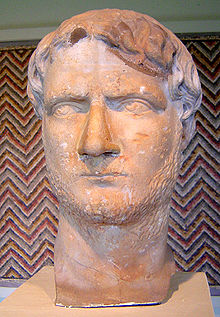
Life
Rise to power
The exact birth date of Gallienus is unknown. The Greek chronicler
John Malalas
and the Epitome de Caesaribus
report that he was about 50 years old at the time of his death, meaning he was
born around 218. He was the son of emperor
Valerian
and
Mariniana
, who may have been of senatorial
rank, possibly the daughter of
Egnatius Victor Marinianus
, and his brother was
Valerianus Minor
. Inscriptions on coins connect
him with Falerii
in
Etruria
, which may have been his birthplace; it
has yielded many inscriptions relating to his mother's family, the Egnatii.[3]
Gallienus married
Cornelia Salonina
about ten years before his
accession to the throne. She was the mother of three princes:
Valerian II
, who died in 258;
Saloninus
, who was named co-emperor but was
murdered in 260 by the army of general Postumus; and
Marinianus
, who was killed in 268, shortly
after his father was assassinated.
When
Valerian
was proclaimed Emperor on 22 October
253, he asked the
Senate
to ratify the elevation of Gallienus to
Caesar and
Augustus
. He was also designated
Consul Ordinarius
for 254. As
Marcus Aurelius
and his adopted brother
Lucius Verus
had done a century earlier,
Gallienus and his father divided the Empire. Valerian left for the East to stem
the Persian threat, and Gallienus remained in Italy to repel the Germanic tribes
on the Rhine
and
Danube
.
Division of the empire
had become necessary due
to its sheer size and the numerous threats it faced, and it facilitated
negotiations with enemies who demanded to communicate directly with the emperor.
Early
reign and the revolt of Ingenuus
Gallienus spent most of his time in the provinces of the Rhine area (Germania
Inferior,
Germania Superior
,
Raetia
, and
Noricum
), though he almost certainly visited
the Danube
area and
Illyricum
during 253 to 258. According to
Eutropius and Aurelius Victor, he was particularly energetic and successful in
preventing invaders from attacking the German provinces and Gaul, despite the
weakness caused by Valerian's march on Italy against
Aemilianus
in 253. According to numismatic
evidence, he seems to have won many victories there, and a victory in
Roman Dacia
might also be dated to that period.
Even the hostile Latin tradition attributes success to him at this time.
In 255 or 257, Gallienus was made Consul again, suggesting that he briefly
visited Rome on those occasions, although no record survives. During his Danube
sojourn (Drinkwater suggests in 255 or 256), he proclaimed his elder son
Valerian II
Caesar and thus official heir to
himself and Valerian I; the boy probably joined Gallienus on campaign at that
time, and when Gallienus moved west to the Rhine provinces in 257, he remained
behind on the Danube as the personification of Imperial authority.
Sometime between 258 and 260 (the exact date is unclear), while Valerian was
distracted with the ongoing invasion of Shapur in the East, and Gallienus was
preoccupied with his problems in the West,
Ingenuus
, governor of at least one of the
Pannonian provinces, took advantage and declared himself emperor. Valerian II
had apparently died on the Danube, most likely in 258. Ingenuus may have been
responsible for that calamity. Alternatively, the defeat and capture of Valerian
at the
battle of Edessa
may have been the trigger for
the subsequent revolts of Ingenuus,
Regalianus
, and
Postumus
. In any case, Gallienus reacted with
great speed. He left his son
Saloninus
as Caesar at
Cologne
, under the supervision of Albanus (or
Silvanus) and the military leadership of Postumus. He then hastily crossed the
Balkans
, taking with him the new cavalry corps
(comitatus) under the command of
Aureolus
and defeated Ingenuus at
Mursa
or
Sirmium
.The victory must be attributed mainly
to the cavalry and its brilliant commander. Ingenuus was killed by his own
guards or committed suicide by drowning himself after the fall of his capital,
Sirmium.
Invasion of the
Alamanni
A major invasion by the
Alemanni
and other Germanic tribes occurred
between 258 and 260 (it is hard to fix the precise date of these
events),probably due to the vacuum left by the withdrawal of troops supporting
Gallienus in the campaign against Ingenuus.
Franks
broke through the lower Rhine, invading
Gaul, some reaching as far as southern Spain, sacking Tarraco (modern
Tarragona
).The Alamanni invaded, probably
through
Agri Decumates
(an area between the upper Rhine
and the upper Danube), likely followed by the
Juthungi
. After devastating Germania Superior
and Raetia (parts of southern
France
and
Switzerland
), they entered Italy, the first
invasion of the Italian peninsula, aside from its most remote northern regions,
since Hannibal
500 years before. When invaders
reached the outskirts of Rome, they were repelled by an improvised army
assembled by the Senate, consisting of local troops (probably prǣtorian guards)
and the strongest of the civilian population.On their retreat through northern
Italy, they were intercepted and defeated in the
battle of Mediolanum
(near present day
Milan
) by Gallienus' army, which had advanced
from Gaul, or from the Balkans after dealing with the Franks.The battle of
Mediolanum was decisive, and the Alamanni didn't bother the empire for the next
ten years. The Juthungi managed to cross the Alps with their valuables and
captives from Italy. An historian in the 19th century suggested that the
initiative of the Senate gave rise to jealousy and suspicion by Gallienus, thus
contributing to his exclusion of senators from military commands.
The revolt of
Regalianus
Around the same time,
Regalianus
, a military commander of
Illyricum
, was proclaimed Emperor. The reasons
for this are unclear, and the Historia Augusta (almost the sole resource
for these events) does not provide a credible story. It is possible the seizure
can be attributed to the discontent of the civilian and military provincials,
who felt the defense of the province was being neglected.
Regalianus held power for some six months and issued coins bearing his image.
After some success against the
Sarmatians
, his revolt was put down by the
invasion of Roxolani
into
Pannonia
, and Regalianus himself was killed
when the invaders took the city of
Sirmium
. There is a suggestion that Gallienus
invited Roxolani to attack Regalianus, but other historians dismiss the
accusation.It is also suggested that the invasion was finally checked by
Gallienus near Verona
and that he directed the restoration of
the province, probably in person.
Capture of Valerian, revolt of Macrianus
In the East, Valerian was confronted with serious troubles. A band of
Scythians
set a naval raid against
Pontus
, in the northern part of modern Turkey.
After ravaging the province, they moved south into
Cappadocia
. Valerian led troops to intercept
them but failed, perhaps because of a plague that gravely weakened his army, as
well as the contemporary invasion of northern
Mesopotamia
by
Shapur I
, ruler of the
Sassanid Empire
.
In 259 or 260, the Roman army was defeated in the
Battle of Edessa
, and Valerian was taken
prisoner. Shapur's army raided
Cilicia
and
Cappadocia
(in present day
Turkey
), sacking, as Shapur's inscriptions
claim, 36 cities. It took a rally by an officer
Callistus
(Balista), a fiscal official named
Fulvius Macrianus
, the remains of the Eastern
Roman legions, and
Odenathus
and his
Palmyrene
horsemen to turn the tide against
Shapur. The Persians were driven back, but Macrianus proclaimed his two sons
Quietus
and
Macrianus
(sometimes misspelled Macrinus) as
emperors. Coins struck for them in major cities of the East indicate
acknowledgement of the usurpation. The two Macriani left Quietus, Ballista, and,
presumably, Odenathus to deal with the Persians while they invaded Europe with
an army of 30,000 men, according to the Historia Augusta. At first they
met no opposition. The Pannonian legions joined the invaders, being resentful of
the absence of Gallienus. He sent his successful commander Aureolus against the
rebels, however, and the decisive battle was fought in the spring or early
summer of 261, most likely in Illyricum, although
Zonaras
locates it in Pannonia. In any case,
the army of the usurpers surrendered, and their two leaders were killed.
In the aftermath of the battle, the rebellion of Postumus had already
started, so Gallienus had no time to deal with the rest of the usurpers, namely
Balista and Quietus. He came to an agreement with Odenathus, who had just
returned from his victorious Persian expedition. Odenathus received the title of
dux Romanorum and besieged the usurpers, who were based at
Emesa
. Eventually, the people of Emesa killed
Quietus, and Odenathus arrested and executed Balista about November 261.
The revolt of Postumus
After the defeat at Edessa, Gallienus lost control over the provinces of
Britain, Spain, parts of Germania, and a large part of Gaul when another
general, Postumus
, declared his own realm (usually known
today as the
Gallic Empire
). The revolt partially coincided
with that of
Macrianus
in the East. Gallienus had installed
his son Saloninus and his guardian,
Silvanus
, in Cologne in 258. Postumus, a
general in command of troops on the banks of the Rhine, defeated some raiders
and took possession of their spoils. Instead of returning it to the original
owners, he preferred to distribute it amongst his soldiers. When news of this
reached Silvanus, he demanded the spoils be sent to him. Postumus made a show of
submission, but his soldiers mutinied and proclaimed him Emperor. Under his
command, they besieged Cologne, and after some weeks the defenders of the city
opened the gates and handed Saloninus and Silvanus to Postumus, who had them
killed. The dating of these events is not accurate, but they apparently occurred
just before the end of 260. Postumus claimed the consulship for himself and one
of his associates, Honoratianus, but according to D.S. Potter, he never tried to
unseat Gallienus or invade Italy.
Upon receiving news of the murder of his son, Gallienus began gathering
forces to face Postumus. The invasion of the Macriani forced him to dispatch
Aureolus with a large force to oppose them, however, leaving him with
insufficient troops to battle Postumus. After some initial defeats, the army of
Aureolus, having defeated the Macriani, rejoined him, and Postumus was expelled.
Aureolus was entrusted with the pursuit and deliberately allowed Postumus to
escape and gather new forces. Gallienus returned in 263 or 265 and surrounded
Postumus in an unnamed Gallic city. During the siege, Gallenus was severely
wounded by an arrow and had to leave the field. The standstill persisted until
the death of Gallienus, and the
Gallic Empire
remained independent until 274.
The revolt of
Aemilianus
In 262, the mint in
Alexandria
started to again issue coins for
Gallienus, demonstrating that Egypt had returned to his control after
suppressing the revolt of the Macriani. In spring of 262, the city was wrenched
by civil unrest as a result of a new revolt. The rebel this time was the prefect
of Egypt,
Lucius Mussius Aemilianus
, who had already
given support to the revolt of the Macriani. The correspondence of bishop
Dionysius of Alexandria
provides a colourful
commentary on the sombre background of invasion, civil war, plague, and famine
that characterized this age.
Knowing he could not afford to lose control of the vital Egyptian granaries,
Gallienus sent his general Theodotus against Aemilianus, probably by a naval
expedition. The decisive battle probably took place near Thebes, and the result
was a clear defeat of Aemilianus. In the aftermath, Gallienus became Consul
three more times in 262, 264, and 266.
Herulian invasions, revolt of Aureolus, conspiracy and death
In the years 267–269, Goths and other barbarians invaded the empire in great
numbers. Sources are extremely confused on the dating of these invasions, the
participants, and their targets. Modern historians are not even able to discern
with certainty whether there were two or more of these invasions or a single
prolonged one. It seems that, at first, a major naval expedition was led by the
Heruli
starting from north of the
Black Sea
and leading in the ravaging of many
cities of Greece (among them,
Athens
and
Sparta
). Then another, even more numerous army
of invaders started a second naval invasion of the empire. The Romans defeated
the barbarians on sea first. Gallienus' army then won a battle in
Thrace
, and the Emperor pursued the invaders.
According to some historians, he was the leader of the army who won the great
Battle of Naissus
, while the majority believes
that the victory must be attributed to his successor,
Claudius II
.
In 268, at some time before or soon after the battle of Naissus, the
authority of Gallienus was challenged by
Aureolus
, commander of the cavalry stationed in
Mediolanum
(Milan),
who was supposed to keep an eye on
Postumus
. Instead, he acted as deputy to
Postumus until the very last days of his revolt, when he seems to have claimed
the throne for himself. The decisive battle took place at what is now
Pontirolo Nuovo
near Milan; Aureolus was
clearly defeated and driven back to Milan. Gallienus laid siege to the city but
was murdered during the siege. There are differing accounts of the murder, but
the sources agree that most of Gallienus' officials wanted him dead. According
to the
Historia Augusta
, an unreliable source compiled
long after the events it describes, a conspiracy was led by the commander of the
guard
Aurelius Heraclianus
and Marcianus.
Cecropius, commander of the Dalmatians, spread the word that the forces of
Aureolus were leaving the city, and Gallienus left his tent without his
bodyguard, only to be struck down by Cecropius.One version has Claudius selected
as Emperor by the conspirators, another chosen by Gallienus on his death bed;
the Historia Augusta was concerned to substantiate the descent of the
Constantinian dynasty
from Claudius, and this
may explain its accounts, which do not involve Claudius in the murder. The other
sources (Zosimus
i.40 and
Zonaras
xii.25) report that the conspiracy was
organized by Heraclianus, Claudius, and
Aurelian
.
According to Aurelius Victor and Zonaras, on hearing the news that Gallienus
was dead, the Senate in Rome ordered the execution of his family (including his
brother Valerianus and son Marinianus) and their supporters, just before
receiving a message from Claudius to spare their lives and deify his
predecessor.
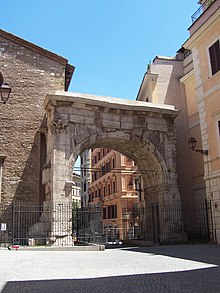
Arch of Gallienus
in Rome, 262 –
dedicated to, rather than built by, Gallienus.
Legacy
Gallienus was not treated favorably by ancient historians, partly due to the
secession of Gaul and
Palmyra
and his inability to win them back.
According to modern scholar Pat Southern, some historians now see him in a more
positive light.Gallienus produced some useful reforms. He contributed to
military history as the first to commission primarily
cavalry
units, the
Comitatenses
, that could be dispatched anywhere
in the Empire in short order. This reform arguably created a precedent for the
future emperors
Diocletian
and
Constantine I
.
The biographer
Aurelius Victor
reports that Gallienus forbade
senators
from becoming military commanders.
This policy undermined senatorial power, as more reliable
equestrian
commanders rose to prominence. In
Southern's view, these reforms and the decline in senatorial influence not only
helped Aurelian to salvage the Empire, but they also make Gallienus one of the
emperors most responsible for the creation of the
Dominate
, along with
Septimius Severus
, Diocletian, and Constantine
I.
By portraying himself with the attributes of the gods on his coinage,
Gallienus began the final separation of the Emperor from his subjects.A late
bust of Gallienus (see above) depicts him with a largely blank face, gazing
heavenward, as seen on the famous stone head of
Constantine I
. One of the last rulers of Rome
to be theoretically called "Princeps", or First Citizen, Gallienus' shrewd
self-promotion assisted in paving the way for those who would be addressed with
the words "Dominus et Deus" (Lord and God).
-
Antoninianus
issued to celebrate
LEG II ITAL VII P VII F, "ItalicaLegio
II seven
times faithful and loyal."
-
Antoninianus issued to celebrate LEG III ITAL VI P VI F,
"ItalicaLegio
III six times
faithful and loyal."
-
Antoninianus issued to celebrate LEG VII MAC VI P VI F,
"MacedonicaLegio
VII six
times faithful and loyal."
-
Antoninianus issued to celebrate LEG VII CLA VI P VI F,
"ClaudiaLegio
VII six
|
